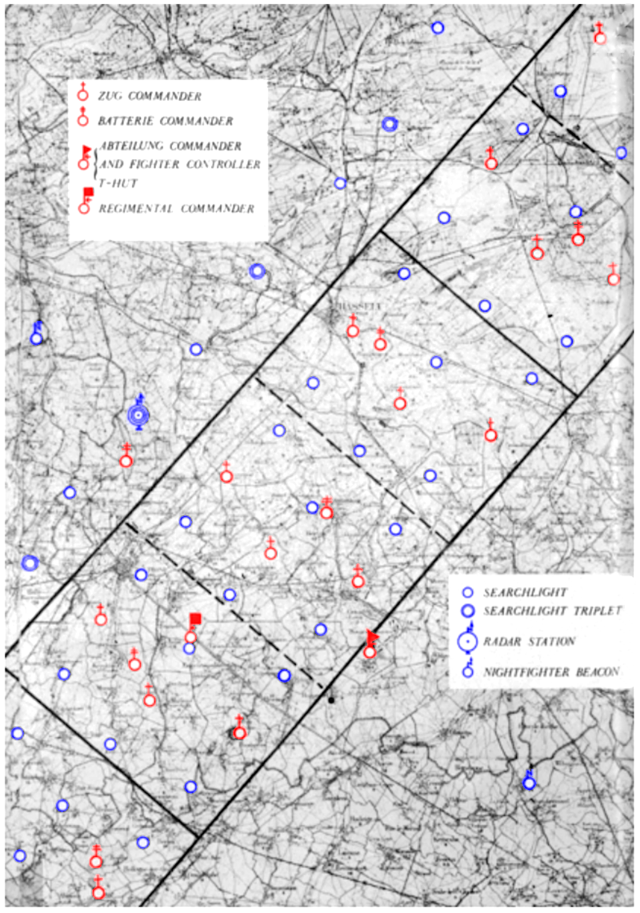Top Qs
Timeline
Chat
Perspective
Heinz-Horst Hißbach
From Wikipedia, the free encyclopedia
Remove ads
Heinz-Horst Hißbach[Note 1] (30 January 1916 – 14 April 1945) was a Luftwaffe night fighter ace and recipient of the Knight's Cross of the Iron Cross (German: Ritterkreuz des Eisernen Kreuzes) during World War II. The Knight's Cross of the Iron Cross was awarded to recognise extreme battlefield bravery or successful military leadership. Heinz-Horst Hißbach claimed 27 aerial victories, 22 of them at night.[Note 2]
Remove ads
Career
Summarize
Perspective
Hißbach was born on 30 January 1916 in Dessau.[1]
Night fighter career

Following the 1939 aerial Battle of the Heligoland Bight, RAF attacks shifted to the cover of darkness, initiating the Defence of the Reich campaign.[2] By mid-1940, Generalmajor (Brigadier General) Josef Kammhuber had established a night air defense system dubbed the Kammhuber Line. It consisted of a series of control sectors equipped with radars and searchlights and an associated night fighter. Each sector named a Himmelbett (canopy bed) would direct the night fighter into visual range with target bombers. In 1941, the Luftwaffe started equipping night fighters with airborne radar such as the Lichtenstein radar. This airborne radar did not come into general use until early 1942.[3]
On 1 November 1944, Hißbach succeeded Major Paul Semrau as Gruppenkommandeur of II. Gruppe of Nachtjagdgeschwader 2 (NJG 2—2nd Night Fighter Wing).[4]
In the night of 14/15 April 1945, Hißbach and his crew of Hubert Varzecha and Max Mayer were killed in action when they were shot down by anti-aircraft artillery. The three were strafing a US resupply column, destroying eight vehicles, in the area of Gelnhausen when their aircraft was hit and exploded.[1] Posthumously, he was awarded the Knight's Cross of the Iron Cross (Ritterkreuz des Eisernen Kreuzes) that day.[5]
Remove ads
Summary of career
Summarize
Perspective
Aerial victory claims
According Spick, Hißbach was credited with 34 nocturnal aerial victories, claimed in approximately 200 combat missions.[6] Foreman, Parry and Mathews, authors of Luftwaffe Night Fighter Claims 1939 – 1945, researched the German Federal Archives and found records for 30 victory claims.[7] Mathews and Foreman also published Luftwaffe Aces — Biographies and Victory Claims, stating that Hißbach claimed more than 29 aerial victories, plus two further unconfirmed claims.[5]
Victory claims were logged to a map-reference (PQ = Planquadrat), for example "PQ DF-DG". The Luftwaffe grid map (Jägermeldenetz) covered all of Europe, western Russia and North Africa and was composed of rectangles measuring 15 minutes of latitude by 30 minutes of longitude, an area of about 360 square miles (930 km2). These sectors were then subdivided into 36 smaller units to give a location area 3 km × 4 km (1.9 mi × 2.5 mi) in size.[8]
Awards
- Flugzeugführerabzeichen
- Front Flying Clasp of the Luftwaffe
- Iron Cross (1939) 2nd and 1st Class
- Honour Goblet of the Luftwaffe (Ehrenpokal der Luftwaffe) on 19 June 1944 as Hauptmann and pilot[38]
- German Cross in Gold on 1 January 1945 as Hauptmann in the 5./Nachtjagdgeschwader 2[39]
- Knight's Cross of the Iron Cross on 15 April 1945 as Hauptmann and Gruppenkommandeur of the II./Nachtjagdgeschwader 2[40][41]
Remove ads
Notes
- For a list of Luftwaffe night fighter aces see List of German World War II night fighter aces.
References
Wikiwand - on
Seamless Wikipedia browsing. On steroids.
Remove ads